Eight Things You Need To Know About Project Ara
Project Ara isn't just about Google inventing a new phone, it's also the company's ATAP team leading the mobile industry by the hand through exactly what the benefits of a module device actually are. With the project still only partway through, plenty of questions still remain, and Google has been picking off some of the concerns during its second developer event in Mountain View today. If you've been wondering about wireless charging, hot-swapping, and even whether you could turn Ara into a potent console alternative, we've got you covered. After the cut, magical magnets, specialist sensors, a big bet on batteries, and more.
Magnets, how do they work?
Project Ara is all about interchangeable modules, and it's magnetism keeping those in place. Google isn't using regular magnets, however, instead turning to what it's calling electro-permanent magnets.
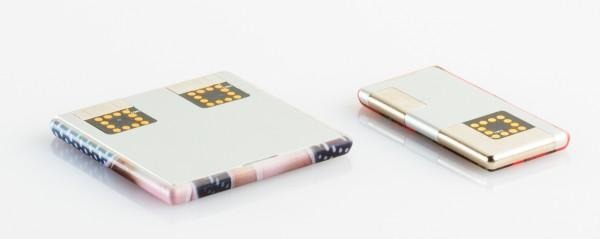
Not quite normal magnets, and not quite electromagnets, instead they allow Google to selectively switch on or off the grip with a short pulse of power. Once that pulse has been triggered, the magnetic pad is toggled, but it doesn't require any continued power after that.
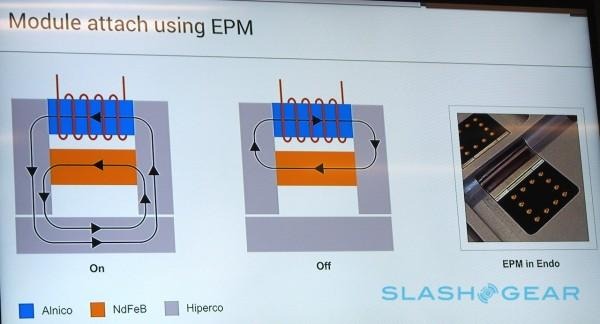
In short, it keeps the modules in place when you want them to stick, and lets them be easily removed when you want to take them out, without placing huge demands on the battery.
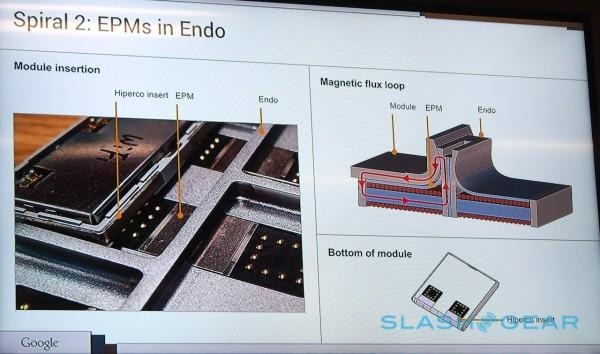
There’s a Pollution Sensor
Google's standard Spiral 2 reference design is – beyond the fact that you can interchange the modules – a pretty standard smartphone. However, that doesn't mean Google hasn't got more interesting blocks in development.
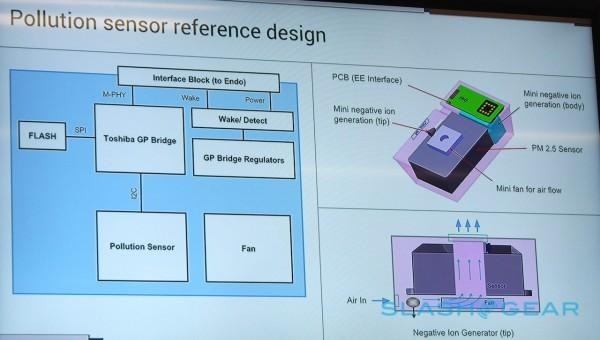
During the developer conference, Google revealed a pollution sensor module it had been working on, squeezing not only a negative ion generator but even a tiny fan into the block. With that module in place, Ara could turn into a portable air quality gage.
Because of the way Ara is designed to integrate each module, the new sensor wouldn't just be seen as an external peripheral, but instead treated as a core component of the handset as if it were designed that way from the start.
Google went halfway on wireless
In Spiral 2, each of the modules connect to the endo using spring-loaded pins; in Spiral 3, those modules will be switched to wireless connections. Using a tiny, standardized pad in each bay on the endo, there'll be a high-speed, short-range link between the two. One of the benefits is a simple aesthetic one: there'll be less chance of leaving scratch marks when the pins drag across the aluminum.
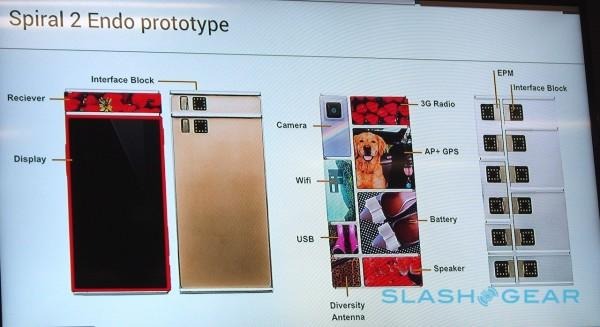
However, what there won't be is wireless power. Google decided that there wasn't a system out there with high enough efficiency for wireless power between the endo and the modules. Whether the phone as a whole will charge wirelessly will depend on which third-party companies weigh in with specialist modules.
Right now, Spiral 2 has a 1x1 block that includes a microUSB port for charging and synchronizing. However, as of Spiral 3 there'll be support for different battery volumes and more, though we'll have to see whether a company like Duracell gets onboard with a wireless charging pad for the Ara platform.
Battery life is going to be complicated
More pieces means more power. Project Ara phones may be able to support more than one battery block at any one time, but then again they'll also be using more power in normal use than a regular phone. Around 20-percent of the battery is currently being demanded by the core interconnectivity between the modules.
Battery life in any modern smartphone is usually a key area of concern, and Google is looking to unusual technologies in order to address the problem – or at least give Ara owners a choice of how they deal with it.
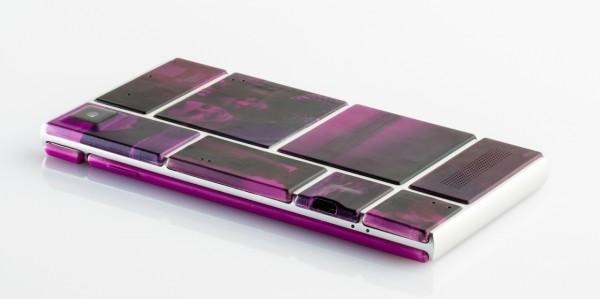
Biggest of those is looking to battery technologies and suppliers that might not currently be found in traditional handsets, notably because they might not meet the roughly 2,000 recharge-cycle baseline that companies like Motorola, Samsung, and LG demand.
Compromising on battery lifespan can lead to packs that actually last longer on each individual charge. Since Ara modules are so readily interchangeable, as long as you didn't mind coughing up for a new battery pack, swapping old for new would take seconds: right now, you have about 30 seconds to do it, though the ATAP team is targeting 1-2 minutes for production models.

Meanwhile, Google argues that by giving such battery technologies a new segment to sell in, that will mean manufacturers can invest in prolonging lifespan along with capacity, which could end up benefitting all mobile devices.
The module goal is “everything just works”
Plugging in an Ara module and then having to sit through a Windows XP-style install process would be a nightmare for usability, so ATAP is focusing on ease of use: both for owners and for app developers. Most of the time, there'll be underlying Linux drivers for all the common hardware and functions, making it plug & play; if a developer has their own drivers, it should only be a matter of 20-30 lines of kernel code to get them playing nicely too.
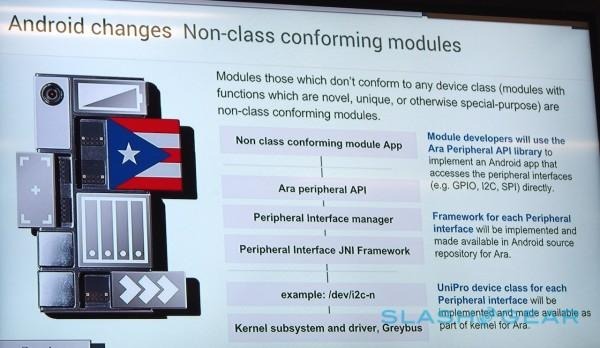
For app developers, meanwhile, there'll be an Ara peripheral API library that will deal with any non class conforming modules, so that they won't need any underlying knowledge to utilize them. As for when you open an app but the relevant hardware isn't present – like running a camera app but without a camera module in place – Google is still working on the mechanism for how that process will work.
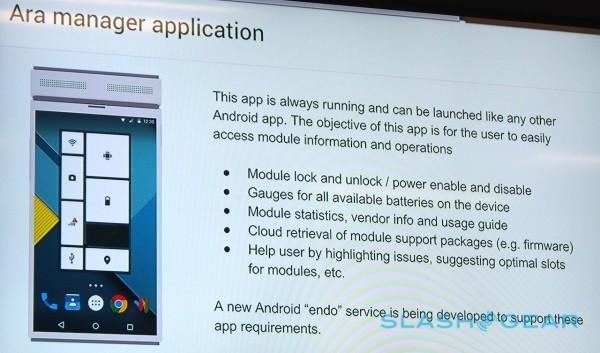
Meanwhile, for actual Ara phone users there'll be a new Android "endo" service and an always-running app to manage the modules. Using a graphic representation of the endo and the modules fitted, there'll be access to locking/unlocking and power enabling/disabling each, gages for the battery status and individual statistics for each block, access to wireless firmware updates, and help guides including suggestions as to which bay would be best for each block.
Security is still a work-in-progress
Yank out an Ara user's modem and you could probably slot it into your own endo and answer their calls. Google seemed surprised at the developer event at just how many questions about security there were from wary developers, worried that snagging a magnetically-attached block could be even easier than lifting a regular handset.
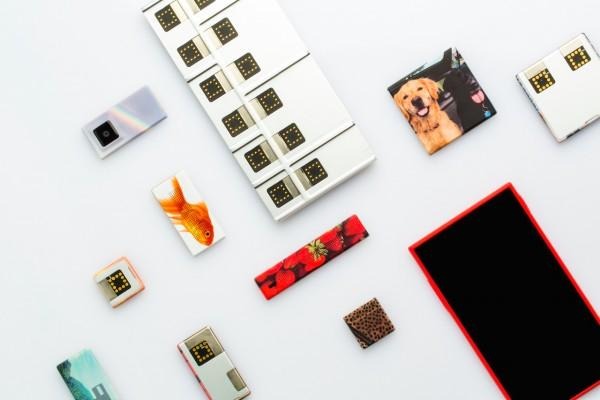
One possibility, the ATAP team suggested, would be an identity module. That would contain all of the user's IDs, security certificates, and other information: removing it would effectively secure the phone altogether.
Whether Ara users could be convinced to regularly remove that module remains to be seen. After all, smartphone users are notoriously lax about setting something as simple as a PIN code or password; physically sliding out a part of their handset might be an even tougher sell.
You could add discrete graphics
Spiral 2 has two different application processors to choose from, one from Marvell and another from NVIDIA. A third, custom chip is in development by Rockwell, though that won't be ready until Spiral 3, expected in Q1 of this year.
However, onboard graphics needn't be the limitation to Ara's visual performance. A discrete GPU could be added as a separate module, the ATAP team confirmed, since the UniPro interconnects are fast enough to support that.
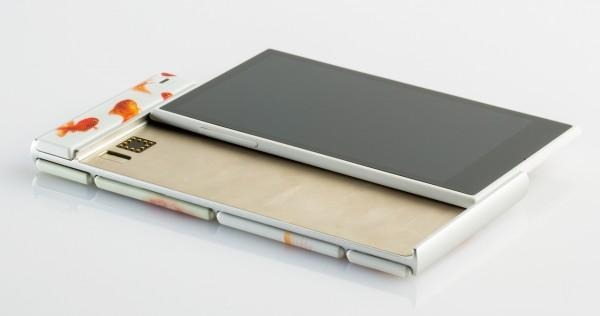
As it stands, Google doesn't have any plans to offer such a module itself. However, if NVIDIA decided to make a GeForce Ara block then it could potentially turn the phone into a potent little console alternative.
Other form-factors are going to follow
A phone is just the start of Project Ara. A familiar device – and familiar functionality – is a sensible place for the ATAP team to begin, but those interchangeable modules needn't end there.
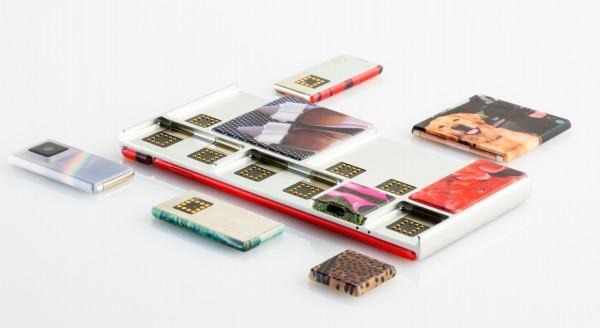
Just about any device with support for accessible bays could potentially come in future. Tablets are another obvious form-factor; however, you could have Ara modules that slot into a car dashboard, or into a wall panel in a smart home.
Before that, though, multiple sizes of smartphone endo are likely to hit the market. Google is keeping a tight rein on the Ara backbone initially, prioritizing compatibility over choice, but eventually plans to license the technology so that third-party endo plates – larger and smaller – could be produced, albeit having to run through a comprehensive testing process so Google can make sure they meet the grade.
